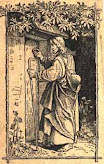Eucharistic Miracle of Fiecht Austria (1310)
 The little village of St. Georgenberg-Fiecht, in the Inn Valley, is very well known, especially for a Eucharistic miracle that took place there in 1310. During the Mass, the priest was seized with temptations regarding the Real Presence of Jesus in the consecrated elements. Right after the consecration, the wine changed into blood and began to boil and overflow the chalice. In 1480, after 170 years, the sacred blood was "still fresh as if it had come out of a wound," wrote the chronicler of those days. It is preserved intact to this day and is contained in the reliquary in the Monastery of St. Georgenberg.
The little village of St. Georgenberg-Fiecht, in the Inn Valley, is very well known, especially for a Eucharistic miracle that took place there in 1310. During the Mass, the priest was seized with temptations regarding the Real Presence of Jesus in the consecrated elements. Right after the consecration, the wine changed into blood and began to boil and overflow the chalice. In 1480, after 170 years, the sacred blood was "still fresh as if it had come out of a wound," wrote the chronicler of those days. It is preserved intact to this day and is contained in the reliquary in the Monastery of St. Georgenberg. Near the side altar of the monastery church there is a documentary tablet that says: "In the year of grace 1310, under Abbot Rupert, a priest was celebrating Holy Mass in this church dedicated to the holy martyr George and the Holy Apostle James. After consecrating the wine, he was seized with a doubt as to whether the Blood of Christ was really present under the species of wine. Suddenly the wine changed into red blood that began to boil in the chalice and overflow it. The abbot and his monks, who happened to be in the choir, and the numerous pilgrims who were present at the celebration, approached the altar and realized what had happened. The priest, terrified, was unable to drink all the Holy Blood, and so the abbot placed the remainder in a vessel in the tabernacle of the main altar near the cloth with which the chalice was wiped. As soon as news of this miraculous event began to spread, more and more pilgrims began to arrive to adore the sacred Blood. So great was the number of the devotees of the Holy Blood that in 1472 Bishop Georg von Brixen sent the abbot of Wilten, Joahannes Lösch, and the pastors, Sigmund Thaur and Kaspar of Absam, to better study the phenomenon.
"As a result of this investigation, the adoration of the Blessed Blood was encouraged and the miracle was declared authentic.
"Among the devotees were important Church personalities, like John, Bishop of Trieste; George, Bishop of Brixen; Rupert, Archbishop of Cologne and Duke of Bavaria; Frederick, Bishop of Chiemsee."
A second documentary tablet recounts how the relic of the Holy Blood helped preserve the Catholic faith during the Protestant schism: "When, in 1593, the teachings of Luther were spreading everywhere in Tyrol, the monks of St. Georgenberg were asked to preach the faith everywhere. Abbot Michael Geisser was preaching with great success before a large crowd in the parish church of Schwaz and did not hesitate to recall the Holy Miracle of the Blood as proof of the existence of the Real Presence of Jesus Christ in the Blessed Sacrament of the Altar. He was disputing in such a convincing way that the adversaries were obliged to leave the scene. This total victory against the false teaching was regarded by the believers as a special grace the Lord was granting his faithful, the adorers of the precious blood."















